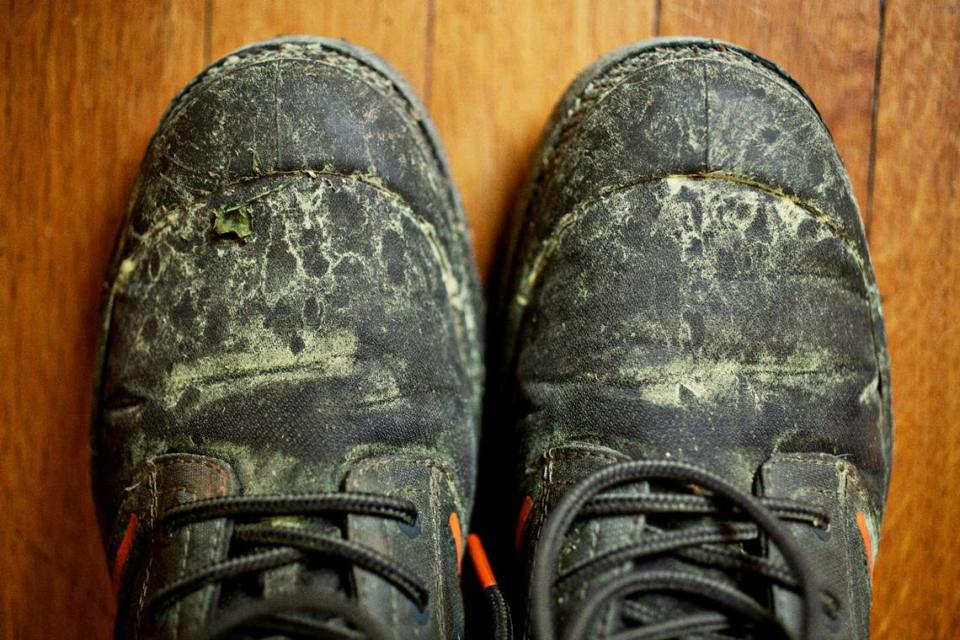The annual Pollening is here, NC. Here’s how to cope and how to get allergy relief
North Carolinians, behold The Pollening that has arrived.
Spring weather in the state is hard to beat, but along with the deliciously mild temps and low humidity comes that thick yellow dusting that covers everything — cars, sidewalks, deck furniture, even our shoes as we walk around outside.
NC tree pollen counts are listed as “high” right now, according to the Department of Environmental Quality’s Nature Research Center, as North Carolina typically reports its highest pollen levels in late March or early April. Plus, we once again had periods of warm weather in February, which causes early blooming and early pollen.
Here’s everything to know about pollen in North Carolina.

When is pollen the worst in NC?
Typically, DEQ’s highest counts in Downtown Raleigh are recorded between the last week of March and the second week of April.
The time of day also matters.
Dr. Saira Sheikh of the UNC Division of Rheumatology, Allergy & Immunology, previously told The News & Observer that pollen counts are typically the highest between 5 and 10 a.m. Pollen counts decline later in the day and into the evening, Sheikh added.
So if you’re planning to be outdoors, “pick a time of the day when the pollen counts are not as high so you’re not feeling worsening symptoms,” Sheikh said.
How bad is the pollen, usually?
If you’re a numbers person, here’s a pollen stat: Over the past seven years, the maximum pollen value each year ranges between about 1,900 and 3,200 grains per cubic meter, according to NCDENR.
Pollen count is calculated by dividing the number of total pollen grains that were collected by 3.12.

How can I monitor pollen counts?
DEQ reports the pollen count from its Raleigh station each day.
The department sends an update from its X (formerly Twitter) account @NCPollen: twitter.com/NCpollen.
You can see the pollen count on the DENR website: xapps.ncdenr.org/aq/ambient/Pollen.jsp
Historical information is available at the department’s website: deq.nc.gov.
How can I protect myself from pollen?
▪ Avoid going outside when pollen counts are highest. Pollen counts are usually highest between 5 and 10 a.m. (peaking around midday) and lower later in the day and into the evening, so if you need to do outdoor activities then — gardening, running, etc. — try to schedule those for later in the afternoon or early evening. It is also a good idea to stay inside when it is windy and right before thunderstorms because the kinds of pollen that cause allergies are blowing everywhere, Sheikh said.
▪ Avoid tracking pollen inside. Sheikh recommends taking your shoes off when you enter your home. If you’ve been outside a lot during the day, it’s also a good idea to take a shower at night to rinse the day’s pollen out of your hair.
▪ Wash your pets. Pets, especially those that spend a lot of time outside, can bring pollen back indoors with them. If you don’t want to wash your dog every night, keep it out of certain rooms in your home. For instance, Sheikh said, maybe don’t let pets sleep in the bed with you during pollen season.
If those steps don’t work, Sheikh said, try taking a long-lasting antihistamine. And if that doesn’t help, Sheikh recommended seeing an allergist or immunologist. (We have more info on that below.)

Is the yellow pollen I see what’s making me sick?
No, the yellow pine pollen coating everything is generally too large to affect allergies, but the yellow pollen is “a critical sign that the pollen is in the air,” Sheikh said.
The kinds of tree pollen that tend to cause allergies in North Carolina include:
American beech
river birch
hickory oak
“If you have any of these trees in your yard and you’re close to a tree, you’re 10 times as likely to have symptoms compared to if the tree was across the street from you,” Sheikh said.
Do I have allergies or COVID-19?
Do you have a fever? That’s the key difference between allergies and COVID, Sheikh said.
A fever is never a symptom of allergies, but it is a key symptom of COVID-19.
“If you have a fever,” Sheikh said, “you may have environmental allergies at baseline, but the fever indicates that you also have something else.”

Should you take OTC meds or get allergy shots?
Do over-the-counter allergy pills work effectively or do you need to escalate to allergy shots?
The News & Observer spoke last year with Dr. Edwin Kim, division chief of UNC Pediatric Allergy & Immunology, to get answers to those questions.
▪ Do allergy pills & nasal sprays work in stronger pollen season? The over-the-counter treatments many of us have been using, such as antihistamine pills and nasal sprays, should still work, Dr. Kim said. But it’s important to begin your medication routine early, and remember that longer allergy seasons mean more time taking these medications.
“Over-the-counter solutions can be effective for many patients, but it’s critical to start these early,” he said. “Over-the-counter solutions are easy to get, don’t require a prescription and, for most patients, control symptoms enough,” he said.
▪ Are shots an option for seasonal allergies? If sufferers are looking for a more permanent solution to seasonal allergies, they can consider allergy shots, also known as immunotherapy, said Kim.
“At my clinic, it’s usually people where medication is not enough, or those where medication works, but they are sick and tired of taking it every day, year after year,” he said.
▪ How do allergy shots work? Allergy shots can stop all allergy symptoms through weekly injections that continue for three to five years.
“Antihistamines and nose sprays don’t change the immune system. So once you stop the medications, the symptoms come right back,” Dr. Kim said.
▪ How can I get allergy shots? Allergists prescribe immunotherapy, which is a series of shots that are intended to stop allergy symptoms.
Skin or blood testing is used to identify the specific allergens (including pollens) a patient might be sensitive to. The allergist then makes a custom prescription for the patient that is taken through weekly injections at a doctor’s office.
The first shot is very dilute, and a slightly stronger dose is given each time. After six months, the dose is no longer increased, and patients may only come in for shots once or twice a month.
The whole process takes between three to five years.
“Patients usually start to feel a little better after two or three months, but we keep patients on for the long duration because with this long treatment, we see patients being able to totally stop their shots and not have their symptoms come back,” Dr. Kim said.
What are the pros and cons of allergy meds vs. shots? Each treatment course has pros and cons. In short:
Over-the-counter solutions are easy, effective and relatively inexpensive, Dr. Kim said. But they don’t change the allergy, and patients may have to take them regularly for many years to stay on top of their discomfort.
Allergy shots can be permanent solutions that get rid of allergies entirely. But they’re a hefty time commitment, and weekly shots for years can get expensive.
Triangle Asked & Answered: What do you want to know?
Have a question about something in our community? The News & Observer’s Service Journalism team wants your questions for our Triangle Asked & Answered series. Reach out to us by filling out this form or by sending an email to ask@newsobserver.com.
Start planning for Biltmore Blooms. What to know about spring at the Asheville estate
Raleigh is getting a new Trader Joe’s. What we know + why you might want to work there

